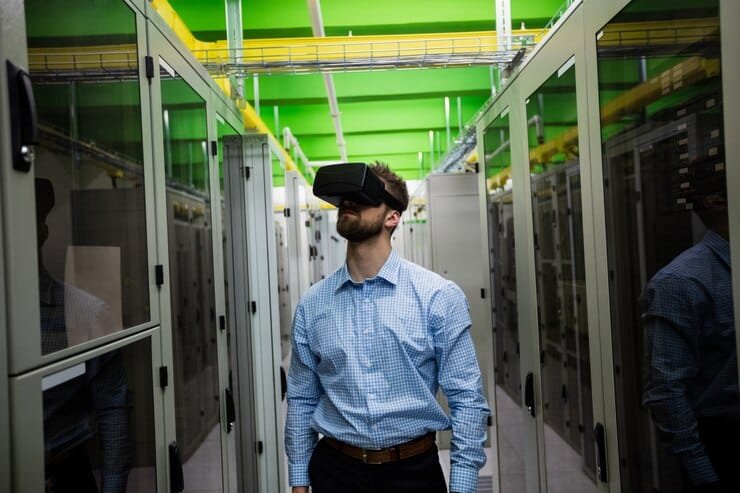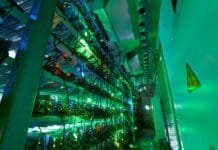Data Centers: Crushing Telecoms or Powering the Future? – An Overview
The tremendous rise in data driven by IoT devices, cloud computing and AI applications is transforming the space globally. At the center of this transformation is the data center, and it’s a monster consuming ever more power and bandwidth. Now PUE (Power Usage Effectiveness) in a typical enterprise data center spikes around 1.6-1.8, a glum tell of how the excess power-arrow of today’s architecture wastes energy. Although this number is an improvement over a decade ago, it is still a huge challenge and worsened with the growing demand for edge computing and hyperscale deployments exponentially.
This increasing demand for energy brings up critical issues leading to the sustainability and scalability of the existing data centre setup. Additionally, the unquenchable thirst for bandwidth is stretching existing telecom networks to their breaking points and has sparked considerations of virtual networks and software-defined networking (SDN) frameworks to alleviate capacity limitations. This very tradeoff between the increasing demands of data centers and the capabilities of already deployed telecom infrastructure is the focus of this analysis.
The Stakes are High: Data center operation efficiency is more than just operational anymore, it’s strategic. For large organizations, downtime translates to millions of dollars per hour in potential losses. Also, data centers have a large carbon footprint, accounting for a significant portion of global greenhouse gas emissions. So, for economic viability and environmental responsibility, it is important that power consumption is made efficient, network become resilient and sustainable practices are applied. In this blog post we will discuss the complex connection between data centers and telecom networks, innovations such as: advanced cooling approaches (i.e. liquid cooling, free air cooling), 5G/6G network integration and optical networking to help mitigate current bottlenecks and open up toward more sustainable and efficient energization. In this session, we will dive into cost-benefit analyses across different possible architectural designs and how they affect end Total Cost of Ownership (TCO).
Key Takeaways on Data Center Infrastructure Market Trends
The data center infrastructure market is emerging rapidly, with multiple drivers creating both opportunities and hurdles for the industry. These trends are divided into positive and adverse, with actionable insights for operational navigation.

I. Positive Trends:
A. Hyperscale growth & edge computing: Hyperscale data centers run by the likes of Google, Amazon (AWS) and Microsoft Azure remain dominant and are increasing demand for high-capacity, high-density infrastructure. At the same time, the growth of edge computing requires a more distributed infrastructure closer to where end-users are located and offers new opportunities for specialized solutions in areas such as micro data centers and edge server deployments.
- Implication: That drives demand for innovative cooling technologies (liquid cooling being adopted by companies like Equinix), advanced power management (Schneider Electric’s EcoStruxure) and specialized networking gears that supports low latency and high bandwidth
- Actionable Insight: Enterprises need modular, scalable solutions that work in hyperscale and edge deployments. More R&D on energy-efficient components and optimized network architectures is essential.
B. AI & ML Driven Optimization: The data centre operations are increasingly being optimized by AI/ML. This includes equipment predictive maintenance, resource allocation automation, energy efficiency through dynamic power management, and many more.
- Impact: This results in lower operational expenses, better uptime, and a smaller environmental impact. AI/ML is becoming a necessity for organizations looking to compete on terms of efficiency and cost.
- Implication: Companies need AI/ML driven solution for data center management in terms of integrating these tools to existing infrastructure and management systems of the organization. Building capabilities in analytics and predictive modeling is vital — not optional.
C. Sustainability Initiatives: With rising environmental awareness, the need for sustainable data center environment is growing. These include harnessing renewable energy, employing innovative cooling techniques, and maximizing energy usage.
- Impact: Environmentally-Cognizant Clients Crave Organizations Committed to Sustainable Practicesmaking for Good PR. Firstly, regulations requiring a reduction in carbon also promote sustainable activity.
- Takeaway: Organizations need to purchase renewable energy, participate in carbon offsetting programs, and use energy-efficient hardware. When it comes to attracting clients, transparency on the environmental impact is paramount through carbon footprint reporting.
II. Adverse Trends:
- Supply Chain Disruptions: Global supply chain challenges continue to affect the availability and price of key components, which contributes to project deployment delays and drives up capital expenditures.
- Effect: It requires diversifying sourcing, strategic inventories, and possibly elevated costs of components.
- Action item: Businesses must build strong ties with several suppliers, embrace just-in-time inventory practices as applicable, and integrate supply chain risk management into planning.
B. Cybersecurity threats: Data centers are a prime target for cyberattacks. The attacks are becoming more sophisticated and an increased security for the company is essential.
- Impact: Data breaches may result in substantial financial loss, loss of reputation and regulatory fines.
- Insight: Companies must heavily invest into advanced security technologies such as intrusion detection systems, firewalls, and strong access controls. Training employees on cybersecurity best practices is just as important.
C. Skilled Labor Shortages: The industry competes for a limited pool of professionals with expertise in data center design, deployment, and management.
- Impact: As a result, labor costs increase and the execution of projects becomes challenging.
- Actionable Insight: Organizations need to focus more on training and development of its emloyees and encourage them with a workplace for ongoing learning. It is also helpful to work with educational institutions to create curricula that is relevant.
Hence, businesses can capitalize on the evolving data center infrastructure market by proactively tackling these trends while also minimizing any risks that would negate the opportunities. 这当中灵活变通、与时俱进和关注可持续发展的问题,至关重要。
Healthcare:Precision MedicineAndGenomics
High-performance computing (HPC) clusters in healthcare datacenters play an important role in analyzing large genomic datasets. Within the industry, hospitals use NVMe-based storage arrays with high IOPS to speed genome sequencing and variant analysis, which in turn allows for faster diagnoses and personalized treatment plans. Real-time data ingestion from medical devices (ex: using MQTT) ingested into the data lake for predictive analytics enabling better patient outcomes. Security is a top priority: we implement zerotrust architectures and strong encryption (AES-256) to protect sensitive patient data.
Technology: Provisioning Cloud Services
Extreme-scale data centers that utilize disaggregated architectures with SDN and NFV form the basis of public cloud providers such as AWS and Azure. These facilities deliver on-demand elastic cloud services through massive clusters of commodity hardware managed by automated orchestration tools such as Kubernetes. High-bandwidth, low-latency interconnects like 400GbE are critical for ensuring the best application performance. Cooling solutions such as liquid cooling systems and AI-powered predictive maintenance are vital for efficiency and uptime.
Automotive: Senior Software Engineer, Autonomous Vehicle Development
These self-autonomous auto generation features are built on top of the data center infrastructure. GPU-accelerated clusters are used to filter, process, and train complex machine learning models on massive datasets generated by both sensor-simulated and real-world driving tests. All these terabytes of sensor data that need to be pushed into data centers require high-speed interconnects (Infiniband) Technologies such as Apache Kafka are used in data pipelines for processing and streaming data in real-time to ensure the models can be properly trained and validated.
Manufacturing: IoT and Predictive Maintenance
Smart factories combine the use of edge computing and cloud data centers. Industrial IOT (IIOT) devices (e.g., sensors on machinery) that collect time Series data streaming in real-time To the cloud to be analyzed. Predictive maintenance is achieved through advanced analytics that highlight patterns to predict equipment failures before they occur and reduce downtime. Industrial sources produce high-volume, high-velocity data stored in time-series databases (e.g., InfluxDB) used in data centers. This necessitates strong network security and access control measures to safeguard sensitive operational fairness data.
Finance: High Frequency Trading (HFT)
Colocation facilities: Financial institutions often have colocated facilities that place their servers in the same building as stock exchanges or in nearby data centers, which drastically reduces latency for high-frequency trading (HFT) operations. These use specialized networking hardware and low-latency interconnects to attain response times in the microsecond range. To support for continuous operation and to minimize impact on trading activities, redundant power supplies and cooling systems are critical. Strong security measures are essential to guard against cyber threats, such as hacking or malware, and ensure adherence to regulations (e.g. PCI DSS).
How to Embrace the Future of AI-Driven Automation
Adoption of AI-driven automation by data center infrastructure providers has been aggressive since 2023. Rather than having to depend entirely on human operators to do such things as provisioning, monitoring, and troubleshooting, they are now adding management platforms that have machine learning algorithms embedded in them. Now, this enables you to identify upcoming issues proactively, mitigate small problems in an automated manner, and allocate your resources more efficiently. For instance, Equinix has been investing a lot in AI to try and predict equipment failures and optimize power usage in its global data centres.
Partnerships and Acquisition (Inorganic Growth)
A major trend is forming, characterized by the formation of strategic partnerships and acquisitions to enhance capabilities and widen market reach. Companies are also looking for partners (AI/ML specialists, software developers, and other technology providers) who can help improve these solutions. For instance, a leading network infrastructure provider may acquire a smaller firm that specializes in edge computing in order to expand its service offering and address the increased demand at edge data centers. That means faster access to emerging technologies and expertise than what you could build in-house.
First leading initiatives towards sustainability
With increasing environmental awareness and regulatory pressures, data center infrastructure companies are making sustainability a key organizational priority. This involves investing in energy-efficient hardware, deploying advanced cooling systems, and using renewable energy sources. Some companies are going so far as to provide carbon offsetting programs to customers to demonstrate the low carbon footprint of their data centers. This commitment is more than corporate social responsibility; it is becoming a differentiator in a competitive environment.
Expansion into Edge Computing
Edge Computing Drivers The growth of IoT and low-latency applications are driving serious investments in edge computing infrastructure. For many, this means building out the edge by creating a constellation of smaller, localized data centers closer to these data sources. This means that they need to adjust their infrastructure management tools and implement new technologies to enable seamless connectivity and optimize performance at the edge. They try to partner with telecoms providers to use existing infrastructure to deplo it faster.
Not hyper-converged Infrastructure (HCI) and Software-Defined Everything (SDx)
A world where HCI and SDx are the foundation seems to be a certain future. The cloud is one way this strategy is executed, consolidating compute, storage, and networking resources into one access platform, simplifying management. Software-defined networking (SDN), and software-defined storage (SDS) are fundamental components that enable centralized control and automation. This requires simplified operations and better agility with deploying and scaling resources, which is even more critical for modern-day data centers, as they also need to respond to evolving business needs.

Outlook & Summary: Data Center Infrastructure’s Next Decade
Laying the Groundwork for a Transformative 5–10 Years The Coming Decade: Data Center Infrastructure Infrastructure ResiliencyDrivers of Change Influencing this TransformationSummary Statute of the Data Center Infrastructure Landscape over the next 5–10 years will look dramatic, with lasting implications for Network Infrastructure Providers (NIPs) We will continue to see, but perhaps slower, growth of hyperscale facilities powered by AI/ML workloads and the metaverse. This expansion is, however, going to increasingly be marked by efficiency, sustainability, and edge computing. Look out for heavy investment in:
Decentralization & Pertaining Edge Deployment: The centralized data centers will be incapable of addressing the latency-sensitive applications and there will be huge investments in edge data centers and decentralized architectures. This will require more collaboration between NIPs and data center operators, which may well blur their roles in the process.
Network Optimization: High-bandwidth, low-latency networking technologies (for example, 5G, fiber optics, etc.) will need to evolve to meet the demand of emerging technologies. NIPs must rework their networks to enable the vastly greater levels of data flows coming out of dispersed data center footprints. This requires the implementation of network slicing through SDN/NFV technologies.
Sustainable Infrastructure: Increasing environmental concerns will place a premium on energy efficiency and renewable sources. This means more free cooling, sub-1.3 optimized PUE targets, and smart grid integration. Firms that have strong ESG strategies will find themselves positioned to gain a competitive advantage.
Automation & AI-enabled Operations: Intelligent automation coupled with AI are emerging as lifelines to cope with the complexity of larger and more distributed data center infrastructures. This ranges from AIOps for predictive maintenance, autonomic network management, resource optimization and more.
Takeaway: The data center infrastructure sector is not slaughtering telecoms, but remaking them in its own image. NIPs that rapidly innovate in line with the decentralized, high-throughput, sustainable, and machine-learning future will prosper. Those that do not fit well into the changing data center landscape will find themselves as a bottleneck in a digital economy. Density of compute per physical square foot in a data center, network capacity, and edge compute are going to determine the winners and losers of the next decade.
Strategic Question: How will Network Infrastructure Providers realign themselves to be essential partners to the increasingly AI-led, distributed data center ecosystem of the future — and not just another supplier of foundational connectivity?






